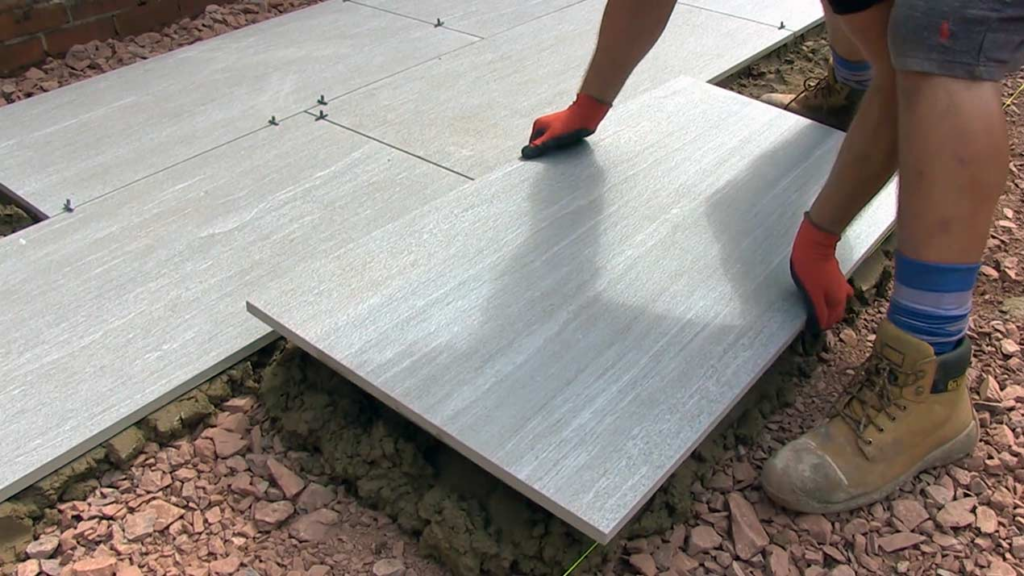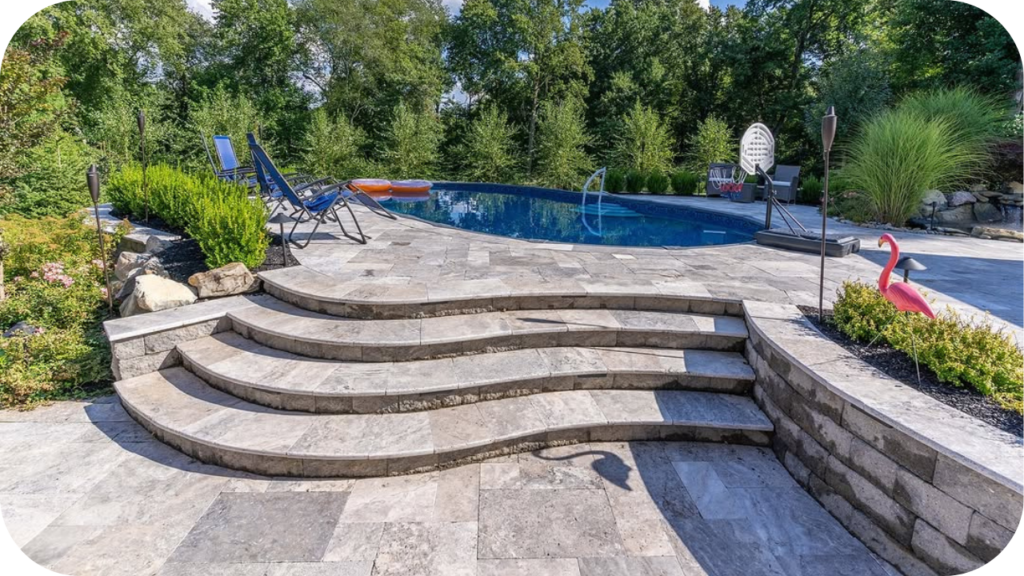
Choosing the right paving material for your outdoor space can be daunting, with numerous options available.
While popular, concrete paving slabs have advantages and disadvantages that can impact durability, aesthetics, and maintenance efforts.
This article delves into the pros and cons of using concrete paving slabs, providing a balanced view to help you make an informed decision about your next landscaping project.
Pros of Using Concrete Paving Slabs
Concrete paving slabs are a popular choice for outdoor spaces due to their numerous benefits. They offer exceptional durability, versatile design options, and low maintenance requirements.
Additionally, their eco-friendly nature makes them an excellent choice for environmentally conscious homeowners. This section explores the key advantages of using concrete paving slabs for landscaping projects.
1. Durability

One of the most significant advantages of concrete paving slabs is their unparalleled durability. These slabs are designed to withstand heavy loads and are ideal for high-traffic areas, such as driveways, patios, and walkways. Their robust composition ensures they resist cracking and chipping, even under extreme weather conditions, including freezing temperatures and intense heat.
Concrete paving slabs are also resistant to wear and tear. Unlike other materials that may degrade over time, concrete maintains its structural integrity, providing a long-lasting solution for outdoor spaces. This durability means fewer repairs and replacements, saving time and money in the long run.
Moreover, the surface of concrete paving slabs can be treated with sealants to enhance their resistance to stains and moisture. This treatment prevents water penetration, which can cause damage and erosion over time. By sealing the slabs, homeowners can ensure their paving remains in excellent condition with minimal maintenance.
2. Versatility

Concrete paving slabs offer versatility, making them ideal for various outdoor projects. Available in an extensive range of shapes, sizes, and colours, these slabs can be tailored to suit any design aesthetic. Whether you prefer a modern, sleek look or a more traditional, rustic feel, concrete paving slabs can accommodate your vision.
One key benefit of this versatility is the ability to create unique patterns and layouts. Homeowners can mix and match different slab styles to produce intricate designs that add character and visual interest to patios, walkways, and driveways.
Additionally, concrete slabs can be stamped or textured to mimic the appearance of more expensive materials like stone or brick, providing a high-end look without the associated cost.
Furthermore, concrete paving slabs are not limited to flat surfaces. They can be used to construct various landscape features, including steps, retaining walls, and garden borders, allowing for seamless integration into your outdoor space. This adaptability ensures that concrete slabs can meet the demands of any project, regardless of complexity.
3. Low Maintenance

One of the standout benefits of concrete paving slabs is their low maintenance requirement. Unlike natural stone or wood, which often require regular sealing or special treatments, concrete slabs are remarkably easy to care for. A simple cleaning routine using water and a mild detergent is typically sufficient to keep them looking their best.
Concrete paving slabs also resist common outdoor issues such as weeds and moss. Their dense surface prevents the growth of these unwanted plants, reducing the need for frequent weeding or herbicide application. This resistance is particularly beneficial for busy homeowners who prefer a beautiful outdoor space without constant upkeep.
Furthermore, concrete slabs are highly durable and less prone to cracking or chipping. This durability means fewer repairs and replacements, contributing to their low-maintenance appeal. Minor stains or spills can be cleaned easily, and more stubborn marks can be removed with a power washer, restoring the slabs to their original appearance.
4. Cost-Effective

Concrete paving slabs offer a cost-effective solution for enhancing outdoor spaces without compromising quality or aesthetics. One primary reason for their affordability is the relatively low cost of raw materials and manufacturing processes compared to natural stone or brick. This makes concrete slabs an attractive option for homeowners seeking a stylish look on a budget.
In addition to their initial affordability, concrete paving slabs provide excellent long-term value. Their durability and resistance to wear and tear mean fewer repairs and replacements over time, which translates to cost savings. Unlike materials that require frequent maintenance or specialised treatments, concrete slabs can be easily cleaned and maintained with minimal expense.
Moreover, concrete paving slabs’ versatility allows various design possibilities without incurring significant additional costs. They can be customised in shape, size, and colour to fit specific design requirements, often mimicking the appearance of more expensive materials. This flexibility enables homeowners to create visually appealing outdoor spaces without exceeding their budget.
5. Environmentally Friendly Options

Concrete paving slabs can be an environmentally friendly option for your outdoor space, offering several sustainable benefits. One of the primary eco-friendly features is using recycled materials in their production. Many manufacturers incorporate recycled aggregates, such as crushed concrete or industrial by-products, reducing the need for virgin raw materials and minimising waste.
Additionally, concrete paving slabs can contribute to sustainable construction practices. They are often produced locally, reducing transportation’s carbon footprint. This local sourcing supports regional economies and promotes sustainable development.
Permeable concrete paving slabs are another environmentally friendly option. These slabs allow water to pass through their surface, reducing runoff and promoting natural groundwater recharge. This permeability helps manage stormwater, reducing the risk of flooding and erosion, and supports sustainable water management practices.
Moreover, concrete paving slabs can be recycled and repurposed at the end of their lifespan, further reducing their environmental impact. This recyclability ensures they contribute to a circular economy, where materials are reused and repurposed rather than discarded.
Cons of Using Concrete Paving Slabs
While concrete paving slabs offer many benefits, it’s important to consider their potential drawbacks. Issues such as cracking, surface wear, discomfort in extreme temperatures, and the need for proper installation can affect their performance and longevity. This section thoroughly explores these cons, helping you decide on your outdoor paving project.
1. Initial Cost

One of the key considerations when choosing concrete paving slabs is the initial cost. While generally more affordable than natural stone or brick, the upfront expense can still be significant, especially for larger projects. The cost of concrete paving slabs varies depending on factors such as thickness, size, design, and finish. Decorative options or custom designs can increase the price per slab.
Additionally, the cost of labour and installation must be factored in. Professional installation is recommended to ensure a stable, long-lasting surface, which can add to the overall expense. Proper site preparation, including excavation, base material, and levelling, is crucial for preventing future issues like shifting or cracking, and these preparatory steps also contribute to the initial cost.
Despite these expenses, concrete paving slabs offer long-term value through their durability and low maintenance requirements. However, budget-conscious homeowners should plan for the initial outlay and consider it within the context of the project’s overall benefits and longevity.
2. Potential for Cracking

Despite their durability, concrete paving slabs have a potential for cracking, an important drawback. Cracks can occur for several reasons, including ground movement, heavy loads, and extreme weather conditions.
Over time, the natural settling of the ground beneath the slabs can lead to shifts that cause the concrete to crack. This is particularly common in areas with significant temperature fluctuations, where the expansion and contraction of the material can lead to stress fractures.
Heavy loads, such as vehicles or large pieces of furniture, can also place excessive pressure on concrete slabs, resulting in cracks. This is especially relevant for driveways and areas with frequent vehicular traffic. Proper installation with a well-prepared base can mitigate some of these risks but cannot completely eliminate the potential for cracking.
Repairing cracks can be costly and may not always restore the slabs to their original appearance. Replacing the affected slabs might be necessary. Homeowners should weigh these risks when choosing concrete paving slabs and consider investing in high-quality materials and professional installation to minimise potential issues.
3. Installation Challenges

Installing concrete paving slabs can present several challenges that homeowners should be aware of. One of the primary difficulties is the need for a properly prepared base. The ground must be excavated and levelled, and a stable base material, such as crushed stone, must be laid to prevent future shifting and cracking. This process can be labour-intensive and time-consuming, requiring precise attention to detail.
Achieving a level surface is crucial for the longevity and appearance of the paving. Uneven installation can lead to water pooling on the surface, which may cause erosion and damage over time. Additionally, ensuring the slabs are correctly spaced and aligned can be tricky, especially for large or complex projects.
Another challenge is the weight of the slabs themselves. Concrete paving slabs are heavy, and handling them requires strength and proper equipment to avoid injury and ensure accurate placement. This often necessitates hiring professional installers, which can add to the overall cost.
4. Aesthetic Limitations

While concrete paving slabs are versatile and functional, they come with certain aesthetic limitations that homeowners should consider. One of the primary concerns is their relatively plain and industrial appearance. Despite advancements in design, concrete slabs may lack the natural beauty and unique textures found in materials like stone or brick. This can make them less appealing for projects where a more organic or high-end look is desired.
Concrete slabs’ colour choices are also limited. Although they can be dyed and treated to mimic other materials, the colour options are generally less varied and may fade over time due to exposure to the elements. This fading can detract from the overall appearance and require periodic re-treatments to maintain the desired look.
Additionally, while concrete slabs can be stamped or textured to add visual interest, these treatments can sometimes appear artificial or repetitive compared to the naturally occurring variations in stone or wood. This uniformity might not suit homeowners seeking a more rustic or eclectic aesthetic.
Conclusion
While concrete paving slabs offer affordability and versatility, their susceptibility to temperature fluctuations and maintenance requirements must be considered.
Homeowners should weigh these factors against their specific climate and aesthetic preferences before choosing concrete. They should explore natural stone or porcelain options tailored to their outdoor space for durable and weather-resistant alternatives.
More To Explore

10 Advantages of Travertine Tiles for Outdoor Landscaping
Travertine tiles remain a popular choice for outdoor landscaping thanks to their balance of natural elegance, durability, and adaptability. Formed over centuries, each tile carries

8 Design Ideas with Outdoor Travertine Tile
Travertine tiles have long been a favourite for outdoor paving, prized for their natural elegance and adaptability across different design styles. Formed over centuries, each


